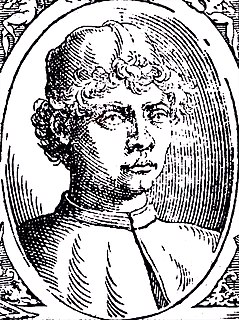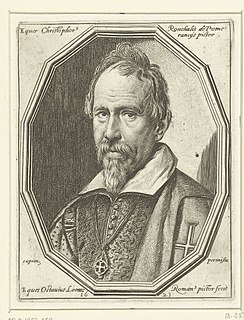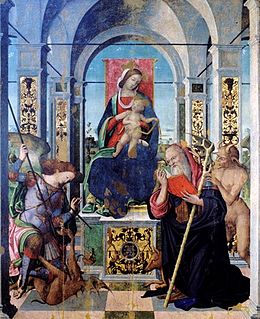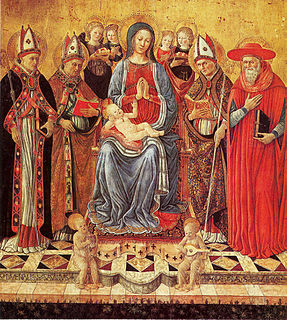Gallery
- Miracle of Saint Anthony (before 1438)
- Crocifissione (Crucifixion)
- Madonna and Child among the Saints (1439)
- Polyptych of Madonna and Child with Saints
- Triptych of Madonna and Child with Saints
Antonio Alberti was an Italian painter, active mainly in the 15th century in his native city of Ferrara, as well as Bologna and Urbino.
He painted portraits and sacred subjects. For the sacristy of the church of San Bernardino, outside Urbino, he painted a Madonna and Child enthroned (1439). He painted frescoes in the Bolognini chapel at San Petronio Basilica in Bologna, consisting of incidents from the Passion, Paradise, and Inferno . He painted frescoes of the Virgin and child between saints Benedict and Sebastian (1433) for the inner choir of Sant' Antonio Abate in Ferrara. He had a son of the same name, who was also an artist, living in 1550. Onofrio Gabrieli and Fra Carnovale were his pupils. His grandson was Timoteo della Vite.

Giovanni Francesco Barbieri, better known as Guercino, or il Guercino[ɡwerˈtʃiːno], was an Italian Baroque painter and draftsman from Cento in the Emilia region, who was active in Rome and Bologna. The vigorous naturalism of his early manner contrasts with the classical equilibrium of his later works. His many drawings are noted for their luminosity and lively style.

Piero della Francesca, originally named Piero di Benedetto, was an Italian painter of the Early Renaissance. To contemporaries he was also known as a mathematician and geometer. Nowadays Piero della Francesca is chiefly appreciated for his art. His painting is characterized by its serene humanism, its use of geometric forms and perspective. His most famous work is the cycle of frescoes The History of the True Cross in the church of San Francesco in the Tuscan town of Arezzo.

Pisanello, born Antonio di Puccio Pisano or Antonio di Puccio da Cereto, also erroneously called Vittore Pisano by Giorgio Vasari, was one of the most distinguished painters of the early Italian Renaissance and Quattrocento. He was acclaimed by poets such as Guarino da Verona and praised by humanists of his time, who compared him to such illustrious names as Cimabue, Phidias and Praxiteles.

Francesco del Cossa was an Italian Renaissance painter of the School of Ferrara, who after 1470 worked in Bologna. Cossa is best known for his frescoes, especially his collaboration with Cosimo Tura on a cycle of the months in the Palazzo Schifanoia of the Este family, rulers of Ferrara. Otherwise, his paintings are mostly of religious subjects, with some portraits and drawings attributed to him. He also designed stained glass.

Benvenuto Tisi was a Late-Renaissance-Mannerist Italian painter of the School of Ferrara. Garofalo's career began attached to the court of the Duke d'Este. His early works have been described as "idyllic", but they often conform to the elaborate conceits favored by the artistically refined Ferrarese court. His nickname, Garofalo, may derive from his habit of signing some works with a picture of a carnation.

Ridolfo di Domenico Bigordi, better known as Ridolfo Ghirlandaio was an Italian Renaissance painter active mainly in Florence. He was the son of Domenico Ghirlandaio.

Francesco Vanni was an Italian painter, draughtsman, printmaker, publisher and printer active in Rome and his native city of Siena.

Luca Longhi was an Italian painter of the late-Renaissance or Mannerist period, active in and near Ravenna, where he mainly produced religious paintings and portraits.

Camillo Procaccini was an Italian painter. He has been posthumously referred to as the Vasari of Lombardy, for his prolific Mannerist fresco decoration.

Cristoforo Roncalli was an Italian mannerist painter. He was one of the three painters known as Pomarancio or Il Pomarancio.

Francesco Trevisani was an Italian painter, active in the period called either early Rococo or late Baroque (barochetto).

Vitale da Bologna, also known as Vitale di Aymo de' Cavalli or Vitale degli Equi, was an Italian painter of the Early Renaissance.

Ottavio Amigoni was an Italian painter of the Baroque period, active in Brescia. He was trained by Antonio Gandini. Among his masterpieces is a large fresco about the life of Sant'Alberto in the Carmelite church of Brescia, painted with Gandino's son, Bernardino.

Vittorio Bigari was an Italian painter of the late-Baroque period.
The decade of the 1430s in art involved some significant events.

Antonio Aleotti was an Italian painter, first mentioned in records in 1494 and active in Ferrara. Born in Argenta, he is also known as Antonio dell'Argento. He painted frescoes in the Chiesa della Morte in Ferrara.

Giovanni Boccati or Giovanni di Pier Matteo Boccati was an Italian painter.

Ottaviano Nelli (1375–1444?) was an Italian painter of the early Quattrocento. Nelli primarily painted frescoes, but also panel paintings. He had several pupils and two painters were influenced by him.

Stefano da Ferrara was an Italian painter from Ferrara who active in the latter half of the 15th century.
Francesco Nasini was an Italian painter of the Baroque period, active mainly in towns outside of Siena, Italy.